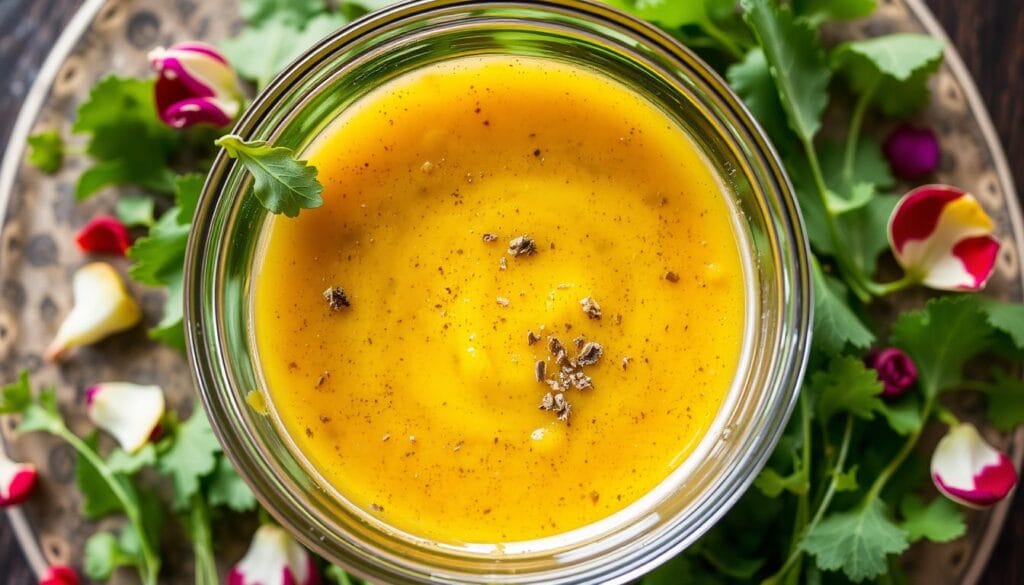Ever looked at a plain salad and wished it was more exciting? I’ve been there too. The key to making ordinary greens into a masterpiece is a tasty homemade salad dressing. Making your own DIY Fresh Salad Dressings is more than just adding flavor. It’s about creating a special dining experience in your kitchen.
Forget about those old bottles from the store. Homemade vinaigrette recipes give you control over what goes in. They offer fresh flavors and the joy of making something just for you. With just a few ingredients, you can make dressings that will make your salads shine.
DIY salad dressings are incredibly versatile. Whether you want something tangy, creamy, or spicy, there’s a recipe for you. From classic vinaigrettes to new flavors, these recipes will change how you see salads.
Table of Contents
Understanding the Basics of Salad Dressings
Making tasty salad dressings is an art. It turns simple greens into amazing dishes. Your journey begins with knowing the basics and using the best Easy Salad Dressing Ingredients.
A great dressing has a mix of flavors that go well with your Healthy Salad Toppings. It’s all about finding harmony between sweet, sour, salty, and umami.
Essential Flavor Components
When making your perfect dressing, remember these key parts:
- Acid (vinegar or citrus) for brightness
- Oil for smooth texture
- Seasoning for depth
- Emulsifiers to blend ingredients
The Power of Fresh Ingredients
Fresh ingredients make your dressing stand out. Quality is more important than quantity. Choose the best oils, fresh herbs, and spices for a gourmet salad.
Your homemade dressings can be tasty and healthy with fresh, good ingredients. Try different mixes to find your favorite flavors.
Essential Ingredients for Homemade Dressings
Making tasty salad dressings starts with knowing the key ingredients. These ingredients turn simple items into something special. You can make your own salad dressings to try new flavors and make your salads better.
Great dressings come from using top-notch, fresh ingredients. These ingredients work well together. Let’s look at what makes homemade dressings so great.
Oils: Choosing the Right Base
The oil you pick changes the dressing’s taste and feel. Most people choose extra virgin olive oil for their dressings. But you can also try:
- Grapeseed oil
- Avocado oil
- Canola oil
- Vegetable oil
Vinegars and Citrus: Adding Zing
Acidic parts like vinegar and citrus add brightness and balance. Here are some vinegar options:
| Vinegar Type | Best Paired With |
|---|---|
| Balsamic | Fruit-based salads (apples, strawberries) |
| Red Wine Vinegar | Bold vegetables (tomatoes, bell peppers) |
| White Wine Vinegar | Delicate flavors (cucumber, sweet corn) |
Tip: Mix half vinegar with fresh citrus juice for a unique dressing.
Herbs and Spices: Boosting Flavor
Fresh herbs and spices make dressings amazing. Try adding:
- 1-2 tablespoons fresh chopped herbs (dill, basil, parsley)
- 1 minced garlic clove
- 2 teaspoons finely minced ginger
- Freshly ground black pepper
Remember, the French vinaigrette ratio is 1 tablespoon vinegar for every 3 tablespoons of oil. This keeps your dressings tasty.
Recipe 1: Classic Vinaigrette
Making homemade vinaigrette is a simple way to make your salads better. This classic vinaigrette adds a restaurant-quality taste to your kitchen with little effort.
To make the perfect vinaigrette, you need just a few ingredients and some basic techniques. Let’s explore how to make a tasty dressing that will make any salad better.
Ingredients You’ll Need
- 2 tablespoons vinegar (white wine or red wine)
- 6 tablespoons extra-virgin olive oil
- 1/4 teaspoon dry mustard
- 1 1/2 teaspoons finely chopped shallots
- 1/8 teaspoon salt
- Freshly ground pepper to taste
- Optional: 1/4 teaspoon dried herbs
Step-by-Step Instructions
- Whisk vinegar, mustard, salt, and pepper in a small bowl
- Slowly drizzle olive oil while continuously whisking
- Add chopped shallots and optional herbs
- Whisk until fully emulsified and smooth
Tips for Customizing Your Vinaigrette
You can easily change your vinaigrette to fit your taste. Try these ideas:
- Swap white wine vinegar for balsamic for a deeper flavor
- Add fresh herbs like basil or thyme
- Include a touch of honey for subtle sweetness
- Experiment with different oils like avocado or walnut
Your homemade vinaigrette will keep in the fridge for up to 3 days. Each serving has about 121 calories and 14g of healthy fats.
Recipe 2: Creamy Avocado Dressing
Make your salads special with this creamy avocado dressing. It’s full of nutrients and tastes amazing. It’s perfect for anyone who loves healthy food and wants to add more flavor to their salads.
Essential Ingredients
Here’s what you need for your dressing:
- 1 ripe avocado
- ½ cup Greek yogurt
- 2 tablespoons fresh lime juice
- Salt and pepper to taste
- Optional: Southwest or Ranch seasoning
Quick Preparation Method
Making this dressing is quick. Just blend everything until it’s smooth. Pro tip: Use a ripe avocado for the best taste and texture.
| Nutritional Information | Per Serving (2 tbsp) |
|---|---|
| Calories | 88 kcal |
| Total Fat | 9g |
| Protein | 1g |
| Carbohydrates | 2g |
Versatile Salad Pairings
This dressing is great on many dishes:
- Mixed green salads
- Southwestern-style salads
- Grilled chicken salads
- Roasted vegetable bowls
Keep your dressing in a sealed container for up to 3 days. For the best taste, keep it cold and use it within 3 days.
Recipe 3: Zesty Lemon-Garlic Dressing
Take your salad to the next level with this zesty lemon-garlic dressing. It’s a low-calorie topping that makes any salad special.
Key Ingredients
You’ll need a few ingredients for this tasty dressing:
- ¾ cup extra-virgin olive oil
- 5 tablespoons red-wine vinegar
- 3 tablespoons fresh lemon juice
- 1 ½ tablespoons Dijon mustard
- 1 clove fresh garlic, grated
- ¾ teaspoon salt
Preparation Steps
Making this dressing is quick and easy. Just follow these steps:
- Grate the garlic clove finely
- Combine all ingredients in a bowl
- Whisk vigorously until fully emulsified
- Taste and adjust seasoning as needed
Usage Tips and Variations
Customize this dressing to your liking:
- Herb Boost: Add 1-2 tablespoons of fresh minced herbs like basil or parsley
- Store in a sealed container in the refrigerator for up to 1 week
- Perfect for 4-6 cups of salad greens
- Yields approximately 10 servings
This dressing is only 130 calories per serving. It’s great for those watching their diet. The acid-to-oil ratio is just right for a balanced taste.
Pro Tip: Chill the prepared salad with dressing for 6-8 hours before serving to enhance the flavor profile.
Recipe 4: Honey-Mustard Dressing
Get ready to transform your salads with a classic honey-mustard dressing. It combines sweet and tangy flavors. This Salad Dressing Variation will become your go-to for adding excitement to your greens. Quick and easy salad recipes start with an incredible homemade dressing like this one.

Creating the perfect honey-mustard dressing is easy. It only needs a few simple ingredients. These Flavorful Salad Boosters will elevate your culinary game with minimal effort.
Ingredients Breakdown
- ½ cup plain Greek yogurt
- ¼ cup extra-virgin olive oil
- ¼ cup Dijon mustard
- 3-4 tablespoons honey
- 2 tablespoons lemon juice
- 1 pressed garlic clove
- ½ teaspoon fine sea salt
- 10 twists freshly ground black pepper
Mixing Instructions
Combine all ingredients in a bowl or blender. Whisk or blend until smooth and well-incorporated. Pro tip: Adjust honey to balance tartness according to your taste preferences.
Perfect Salad Combinations
This versatile dressing pairs beautifully with grilled chicken salads, crisp mixed greens, and roasted vegetable medleys. Its bold flavor profile makes it a standout choice for your meal prep and quick lunches.
Nutrition highlights include just 231 calories per serving, with 21g of total fat and 9g of carbohydrates. The dressing keeps well in the refrigerator for 10-14 days, making it a convenient and delicious addition to your kitchen repertoire.
Recipe 5: Herbed Yogurt Dressing
Discover a delightful Fresh Herb Salad Dressings recipe that turns your salads into nutritious masterpieces. This herbed yogurt dressing is creamy and tangy. It’s perfect for health-conscious food lovers who want Healthy Salad Toppings with lots of flavor.
Essential Ingredients for Your Dressing
Choosing the right ingredients is key to making a great yogurt-based dressing. Here’s what you’ll need:
- ½ cup non-fat Greek yogurt
- 2 garlic cubes or 1 minced clove
- 2 ½ tablespoons red wine vinegar
- ¼ cup fresh dill (or preferred herb)
- Salt and pepper to taste
Simple Mixing Directions
Making this dressing is easy. Just whisk all ingredients together until smooth. This ensures the herbs and spices are evenly spread. For a thinner dressing, add 1-2 tablespoons of water.
Nutritional Powerhouse: Health Benefits Explained
Your homemade herbed yogurt dressing is not only tasty—it’s also packed with nutrients. Here are some impressive stats:
| Nutritional Aspect | Per Serving |
|---|---|
| Calories | 17-25 kcal |
| Protein | 2-4 g |
| Carbohydrates | 1.7-3 g |
| Fat | 1.5-4 g |
“A spoonful of this dressing brings nutrition and excitement to your plate!” – Culinary Experts
Keep your Fresh Herb Salad Dressings in an airtight container. They’ll stay fresh for 3-4 days in the fridge. This makes meal prep easy.
Pro tip: Try different herbs to customize your Healthy Salad Toppings. This keeps your meals exciting!
Storing Your Homemade Dressings
Making DIY fresh salad dressings at home means you need to store them right. This keeps their taste and safety good. Knowing how to keep your easy salad dressing ingredients fresh is key to enjoying tasty dressings all week.
Storing homemade dressings right is important for their shelf life. Most will last 3 to 4 days in the fridge. But, different dressings last longer or shorter times:
- Vinaigrettes: Up to 4 days
- Creamy dressings: 3-4 days
- Dressings with fresh herbs: Best consumed within 2-3 days
Best Practices for Refrigeration
To keep your homemade dressings fresh longer, follow these tips:
- Use clean, airtight glass containers with tight-fitting lids
- Store at consistent refrigerator temperatures (around 40°F)
- Always use clean utensils when handling
- Keep containers sealed when not in use
How Long Do They Last?
Watch for signs of spoilage in your easy salad dressing ingredients, including:
- Unusual color changes
- Mold growth
- Sour or rancid smell
- Significant separation beyond normal settling
Pro tip: Creamy dressings with dairy or eggs spoil faster than acidic vinaigrettes. If unsure, throw it out. Trust your senses.
Creative Uses for Salad Dressings Beyond Salads
Customizable salad dressings are more than just for salads. They can turn simple dishes into something special. Just a little creativity can make a big difference.

Learn how your homemade dressings can be used in many ways. They can make different dishes taste better:
- Marinades for chicken and fish
- Dips for fresh vegetables
- Drizzling over roasted vegetables
- Enhancing grain bowls
- Sandwich and wrap flavor boosters
Marinades that Maximize Flavor
Oil-based vinaigrettes are great for marinating chicken and fish. A citrus dressing can make proteins tender and flavorful. For the best taste, marinate for 30 minutes before cooking.
Transformative Dips and Drizzles
Your salad dressings can be amazing dips for veggies, crackers, and bread. Creamy dressings like ranch or herb-infused ones add rich flavors. They make snacking more fun.
| Dressing Type | Best Uses |
|---|---|
| Vinaigrette | Marinades, grain bowl topping |
| Creamy Dressings | Vegetable dips, roasted potato seasoning |
| Citrus-Based | Seafood marinades, vegetable glazing |
Roasted Vegetable Magic
Drizzling salad dressings on roasted veggies makes them taste amazing. A light vinaigrette coating helps them get golden and stay moist.
Transform your ordinary meals into extraordinary culinary experiences with a simple drizzle of homemade dressing!
Common Mistakes to Avoid in DIY Dressings
Making perfect DIY salad dressings takes practice and focus. While it’s simple to make your own, many mistakes can ruin the taste and texture.
Mastering Flavor Balance
Getting the flavor right is key in DIY salad dressings. Many home cooks find it hard to mix the right ingredients. The goal is to blend:
- Sweetness
- Acidity
- Saltiness
- Herbal notes
Start by tasting your dressing as you mix it. A pinch of salt or a splash of vinegar can make a big difference. Remember, different ingredients work together in unique ways, so be patient.
Emulsification Techniques
Emulsification is what sets pros apart from beginners. When making salad dressings, you want everything to mix well without separating. Here’s how:
- Whisk vigorously or use a blender
- Add oil slowly while mixing
- Use an emulsifier like mustard or egg yolk
Using cold ingredients can mess up emulsification. Let your ingredients warm up to room temperature before mixing.
Pro tip: A mason jar works wonderfully for mixing and storing homemade dressings!
By knowing these common mistakes, you can make salad dressings as good as those in restaurants. Experiment, taste, and enjoy making your own unique dressing.
Adding Nutritional Boosts to Your Dressings
Improving your salad dressings is more than just adding flavor. You can make them super healthy. By adding special ingredients, your salad will become a nutritional powerhouse.
Superfoods are a great way to make your dressing healthier. Here are some amazing ingredients to try:
- Chia seeds: Packed with omega-3 fatty acids
- Spirulina: A protein-rich blue-green algae
- Flaxseeds: Rich in fiber and lignans
- Hemp seeds: Providing complete protein
Superfoods to Consider
Healthy Salad Toppings do more than just look good. Nutritional yeast is a standout. It adds flavor and lots of nutrients. This yeast is a complete protein, full of B-vitamins and minerals.
Studies show that high-fat dressings help your body absorb nutrients better. Olive oil and avocado not only taste great but also help your body get more from your salad.
Enhancing Taste with Nutritional Yeast
Nutritional yeast gives your dressings a cheesy, nutty taste. It also boosts their health benefits. Add it to your homemade dressings for a nutritional boost that’s delicious.
Pro tip: Start with small amounts of superfoods and gradually increase to find your perfect balance of nutrition and flavor.
Conclusion: Elevate Your Salad Game
Your journey into making DIY salad dressings has opened up a world of possibilities. Homemade dressings let you turn simple greens into amazing meals with ease and flavor.
By making your own, you can pick the ingredients and try out new flavors. You can go from zesty lemon-garlic to creamy yogurt-based, and beyond. The choices are endless.
Getting better at making dressings takes time. Begin with simple recipes and mix different ingredients. Don’t hesitate to try new things. Your taste buds will love the fresh, tasty salads you make at home.
With a little time and a bit of creativity, you can make salads truly special. Your homemade dressings will make meals better and offer healthier options than store-bought ones.

